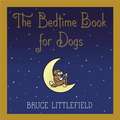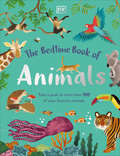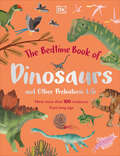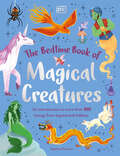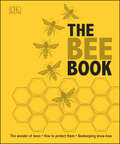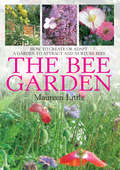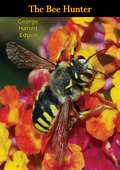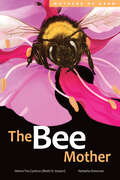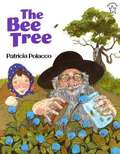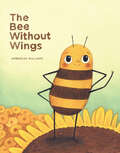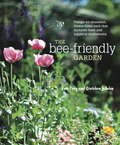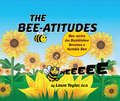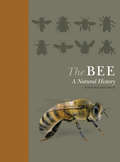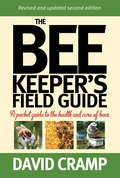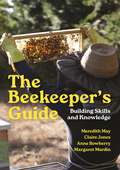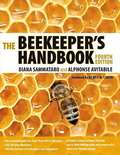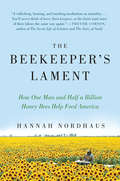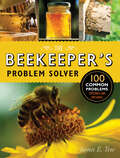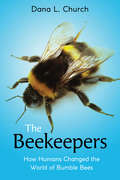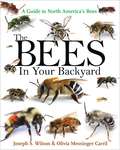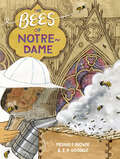- Table View
- List View
The Bedtime Book for Dogs
by Bruce LittlefieldCome. Sit. Stay. I want to tell you a story. I think you'll like it. It's about a TREAT and a good dog, a very good dog who wanted to go play. But his friend was busy....THE BEDTIME BOOK FOR DOGS is a charming story about a dog who decides that he'd rather walk to the park by himself than wait for his human companion-and discovers that all of his usual activities aren't as much fun without a good friend to share them with. This is an adorably packaged book with illustrations by Paul Heath that makes a perfect gift for dog lovers of all ages, with words dogs will understand and kids will want to read again and again.
The Bedtime Book of Animals (The Bedtime Books)
by DKA must-have illustrated introduction to the animal kingdom, including over 50 of the world&’s favorite animals! Introducing The Bedtime Book of Animals, a must-have animal reference book for all early readers who are keen to explore animals from all over the globe. Turn each page to find out more about a wide variety of animals, from teeny-tiny insects to gigantic elephants and whales. The Bedtime Book of Animals showcases creatures from each of the core animal groups (mammals, birds, reptiles, amphibians, fish, and invertebrates) in six dedicated chapters. Many pages are devoted to a different creature, with others featuring a collection of animals from the same family, and some explore more than one animal type, giving bite-sized chunks of accessible information to help early learners get to know new species.A fun-filled journey into the animal kingdom awaits you, promising: - A must-have introduction to a wide variety of animals from around the world- Introduces essential information about each species in a friendly, accessible way- Colorfully illustrated, with light annotation of key features- Reinforces early animal vocabulary, and builds awareness of connections in the animal kingdom- Fully illustrated, with a bright color palette and fresh feel. From rabbits and red pandas, starfish to songbirds, The Bedtime Book of Animals is a beautiful, fully-illustrated and, engaging picture book with read-alout text– perfect for parents/carers and children to enjoy at bedtime. A must-have volume to add to every 3-5 year old&’s library, this is a one-hit introduction to animals, featuring more than 50 best-loved and lesser-known animals from around the world. Did you know that the topic of animals is universally popular and this is a tried-and-tested non-fiction genre, which can help to develop early understanding of the natural world in young readers, as well as develop soft skills such as empathy, kindness and care in 3-5-year-olds? Perfect for parents and educators seeking to introduce core animal knowledge at a young age, including how to recognize animals, animal categorization and key features. A friendly, factual, timeless gift book, The Bedtime Book of Animals will be treasured forever.
The Bedtime Book of Dinosaurs and Other Prehistoric Life: Meet More Than 100 Creatures From Long Ago (The Bedtime Books)
by Dean LomaxGet to know more than 100 of the world&’s favorite dinosaurs and other prehistoric life forms with this essential illustrated introduction.This must-have first book on dinosaurs and other ancient creatures is filled with beautiful illustrations and storybook text on every page, perfect for early readers who want to know more about the life that once roamed our planet. The Bedtime Book of Dinosaurs and other Prehistoric Life includes the earliest life that appeared in the ocean, to the giant dinosaurs, and the wonderfully weird mammals that followed them. Children aged 3-5 can discover a huge variety of organisms that are shown within the three chapters, which cover the Paleozoic, Mesozoic, and Cenozoic eras. With old favorites, such as Tyrannosaurus and Triceratops, as well as new discoveries, including Yi and Changmiania, there is something for every young fan of the primeval world.Inside the pages of this exciting dinosaur book, you&’ll find:- An introduction to the essential information about each prehistoric species in a friendly, accessible way.- Beautiful and accurate illustrations combined with introductory reference text about a wide variety of dinosaurs and other ancient plants and animals.- Engaging text for young children that can be read aloud – perfect for parents, carers, and children to enjoy at bedtime. - A one-hit introduction to prehistoric life, featuring more than 100 animals - an essential addition to every 3–5 year old&’s library.This exciting dinosaur guide helps to develop an early understanding of the prehistoric world for little ones and clearly explains the key features of each animal or plant, as well as how to say their names. A timeless gift book, this is a must-have for parents, carers, and educators who want to introduce core dinosaur knowledge at a young age in a fun and engaging way.
The Bedtime Book of Magical Creatures: An Introduction to More than 100 Creatures from Legend and Folklore (The Bedtime Books)
by Stephen KrenskySay hello to more than 100 of your favorite magical creatures with this delightful, illustrated introduction.This is the must-have bedtime book about the world's most fantastical creatures from around the world. Turn each page to find out more about the amazing variety of magical creatures—from fairies and mermaids to dragons and unicorns.With charming illustrations, storybook text, and key terms highlighted on each page, this book is a wonderful and comprehensive introduction to magical creatures. The book showcases beings from land, water, and air, in three comprehensive chapters. Many pages are devoted to a particular creature, with others featuring a collection of similar beings, such as witches and genies, giving bite-sized chunks of accessible information to help early learners get to know more about their favourite creature from myths, legends, and story books. There are also reference pages at the end of the book that give more information on the context and origins of each creature.A timeless gift book, The Bedtime Book of Magical Creatures will be treasured for years to come.
The Bee Book (Conservation for Kids)
by Charlotte MilnerDiscover more about our fuzzy little insect friends with award-winning author and illustrator Charlotte Milner. The perfect introduction to bee conservation for little ones. Learn all about the beautiful world of bees and their adventure from flower to flower. You'll find out just how much they matter, why they are declining, and what we can do to help in this adorable kids' ebook. Bees are brilliant at building, super social creatures and along with other insects, are responsible for a third of every mouthful of food you eat! Children will be fascinated by the beautiful pictures and learn plenty of buzz-worthy fun facts in every chapter, covering types of bees, beehives, beekeeping, how they pollinate plants and make honey.A beautiful kid&’s educational ebook about bees with a crucial message: not only does it inform and educate about an issue that is a real threat, but it also delivers it in a way that is gripping for all ages. A dazzling celebration of bees, packaged in a gorgeous ebook with spectacular illustrations.What&’s The Buzz About Honey Bees?Meet the humble honeybee face-to-face - an animal that is considered nature's hardest worker, in this engaging, educational kids&’ ebook that you can treasure forever.What do they do all day? Why are bees important? Find out why they need our help and what you can do. Bees are responsible for so much more than making honey. This ebook is an essential tool in encouraging the protection of our precious buzzing friends for generations to come.Learn all about these valuable creatures:- What happens in the hive- What pollination is- Who the queen is- How honeybees talk to each other- How we can help them and much, much more!This adorable book is one of three children's books on conservation by award-winning author Charlotte Milner and includes The Sea Book and The Bat Book for your little ones to enjoy.
The Bee Book: Discover the Wonder of Bees and How to Protect Them for Generations to Come
by DKThe Bee Book shows you step-by-step how to create a bee-friendly garden, get started in beekeeping, and harness the power of honey for well-being.Fully illustrated with full-color photographs throughout, this beautiful guide covers everything you need to know to start your own backyard hive, from setup to harvest. Practical beekeeping techniques are explained with clear step-by-step sequences, photos, and diagrams so you'll be prepared to establish your own colony, deal with diseases, collect a swarm, and much more.A comprehensive gardening chapter features planting plans to fill container and border gardens, bee "hotel" and habitat projects, and an at-a-glance flower gallery of bees' favorite plants. The Bee Book also shows you how to harvest honey, beeswax, and propolis from the hive and use these ingredients in 38 recipes for home remedies, beauty treatments, and candle-making.Discover the wonder of bees in nature, in your garden, and in the hive with The Bee Book, lavishly bound in a beautiful gold-foil and texture cover and perfect for gift giving.
The Bee Garden: How To Create Or Adapt A Garden To Attract And Nurture Bees
by Maureen LittleBees play a vital and irreplaceable role in pollinating our flowers, fruits and vegetables. The more bees in your garden the healthier, more productive and more pleasant a place it will be. Yet bees are declining rapidly and many people, even if they do not wish to keep bees themselves, are asking what can be done on an individual basis to help the bee. This book is a response to that request. It will demonstrate in one accessible volume how each of us can play our part in providing a bee-friendly environment, no matter how much gardening space and/or time we may have. It includes: * How bees forage, what bees you can expect to find in your garden and what plants are best for them. * Why honey bees are so important; what they need to thrive and how they detect and access those requirements; and what varieties of plants are best suited to provide those needs. * How the gardener can offer and maintain a bee-friendly garden, followed by a season-by-season account of what beefriendly plants are in flower and when, and what jobs the gardener can be doing during these times to help bees thrive. * A gazetteer of selected bee-friendly plants, arranged by type of plant in seasonal sub-sections. * Illustrative, practical planting plans, including a culinary herb garden, a potager, a wild flower garden, and a 3 seasons traditional border.
The Bee Garden: How to Create or Adapt a Garden to Attract and Nurture Bees
by Maureen LittleBees play a vital and irreplaceable role in pollinating our flowers, fruits and vegetables. The more bees in your garden the healthier, more productive and more pleasant a place it will be. Yet bees are declining rapidly and many people, even if they do not wish to keep bees themselves, are asking what can be done on an individual basis to help the bee. This book is a response to that request. It will demonstrate in one accessible volume how each of us can play our part in providing a bee-friendly environment, no matter how much gardening space and/or time we may have. It includes: * How bees forage, what bees you can expect to find in your garden and what plants are best for them. * Why honey bees are so important; what they need to thrive and how they detect and access those requirements; and what varieties of plants are best suited to provide those needs. * How the gardener can offer and maintain a bee-friendly garden, followed by a season-by-season account of what beefriendly plants are in flower and when, and what jobs the gardener can be doing during these times to help bees thrive. * A gazetteer of selected bee-friendly plants, arranged by type of plant in seasonal sub-sections. * Illustrative, practical planting plans, including a culinary herb garden, a potager, a wild flower garden, and a 3 seasons traditional border.
The Bee Hunter
by George Harold EdgellOriginally published in 1949, this amusing and informative little book gives a charming account of an avocation seriously pursued by the author for fifty summers. It provides as well, with clarity and wit, a manual for lovers of nature (and wild honey) who might wish to undertake this ingenious sport. George Harold Edgell sticks his neck out on the first page and says no other book describing the proper approach to wild bees exists. “It is time,” he says, “for someone who has hunted bees and found bee trees to write the facts.”
The Bee Mother (Mothers of Xsan)
by Hetxw’ms Gyetxw HusonLearn about the life cycles of different kinds of bees in this enlightening picture book. As flowers and trees begin to bud and bloom, Nox Ap, the bee mother, emerges from her winter sleep. To the Gitxsan, she is nature&’s gardener. Without her hard work as a pollinator, we could not enjoy the fruits of strawberries and huckleberries. Follow her life from the first thaw of spring to the end of autumn. In the seventh book of Hetxw'ms Gyetxw (Brett D. Huson)&’s Mothers of Xsan series, readers will discover the important role of the bumblebee, the honeybee, and the yellow jacket wasp in the Xsan ecosystem.
The Bee Tree
by Patricia PolaccoWhen Mary Ellen gets bored with her reading, Grandpa knows a hunt for a bee tree is just what she needs. <P><P>Half the town joins the exciting chase, but it's not until everyone returns home that Mary Ellen makes a discovery of her own: Sometimes, even the sweetest of things must be worked for. 'Polacco has created another charming picture book featuring a child learning from a grandparent in an idyllic pastoral setting?Both the writing and artwork are fresh and inviting. ' ? School Library Journal, starred review?The newest gem from Polacco's treasure chest of family stories extols the virtue of reading'and of taking a study break. 'Like Mary Ellen, readers will emerge refreshed from this respite, ready to seek out new adventures. ' ? Publishers Weekly?Young readers will savor this. '? ? The Horn BookPatricia Polacco lives in Union City, MI.
The Bee Without Wings
by Amberlea WilliamsAn unexpected friendship between a girl and a wingless bee warmly teaches young readers about friendship and loss in this heartfelt tale for fans of Charlotte's Web and The Honeybee.Finding a bumble bee without wings in her garden, Sasha is determined to help it survive, leading to an unexpected friendship. Sasha, Molly the cat, and Bea the bee share a joyful summer together and discover that you don't need wings to fly. When the time comes to say goodbye to Bea, Sasha finds a meaningful way to honor the life of her tiny friend.The Bee Without Wings is a timeless story of friendship and loss for young readers, beautifully illustrated by author Amberlea Williams. This warm tale includes an activity for creating a bee pollinator garden, along with information on how to care for early spring bees.
The Bee-Friendly Garden
by Gretchen Lebuhn Kate FreyThis guide to designing a bee garden helps gardeners create a stunningly colorful, vibrant, healthy habitat that attracts both honeybees and native bees. In The Bee-Friendly Garden, award-winning garden designer Kate Frey and bee expert Gretchen LeBuhn provide everything you need to know to create a stunningly colorful, vibrant, safe, healthy garden that helps both the threatened honeybee and native bees. No matter how small or large your space, and regardless of whether you live in the city, suburbs, or country, just a few simple changes to your garden can fight the effects of colony collapse disorder and the worldwide decline in bee population that threatens our global food chain. There are many personal benefits of having a bee garden as well! Bee gardens: · contain a gorgeous variety of flowers · bloom continuously throughout the seasons · are organic, pesticide-free, and ecologically sustainable · develop healthy and fertile soil · attract birds, butterflies, and other beneficial insects · increase the quantity of your fruit and vegetable harvest · improve the quality, flavor, and size of your produce Illustrated with spectacular full-color photos, The Bee-Friendly Garden debunks myths about bees, explains seasonal flower progression, and provides detailed instructions for nest boxes and water features. From "super blooming" flowers to regional plant lists and plants to avoid, The Bee-Friendly Garden is an essential tool for every gardener who cares about the planet and wants to make their yard a welcoming habitat for nature's most productive pollinator.From the Trade Paperback edition.
The Bee-atitudes: Bee-atrice the Bumblebee Becomes a Humble Bee
by Laura TaylorBee-atrice is a prideful bumblebee who refuses to identify as a worker bee. She never takes her work seriously and tries to show the rest of the hive that she is the grandest of them all. However, as Bee-atrice begins to understand the true meaning of responsibility and teamwork, her heart starts to change. Discover, alongside Bee-atrice, why humility triumphs over pride. You will enjoy reading about the life cycle of bumblebees and learning how our actions, whether good or bad, can impact those around us.
The Bee: A Natural History
by Noah Wilson-Rich Kelly Allin Norman Carreck Andrea QuigleyBees pollinate more than 130 fruit, vegetable, and seed crops that we rely on to survive. Bees are crucial to the reproduction and diversity of flowering plants, and the economic contributions of these irreplaceable insects measure in the tens of billions of dollars each year. Yet bees are dying at an alarming rate, threatening food supplies and ecosystems around the world. In this richly illustrated natural history of the bee, Noah Wilson-Rich and his team of bee experts provide a window into the vitally important role that bees play in the life of our planet. Earth is home to more than 20,000 bee species, from fluorescent-colored orchid bees and sweat bees to flower-nesting squash bees and leaf-cutter bees. This book takes an incomparable look at this astounding diversity, blending an engaging narrative with practical, hands-on discussions of such topics as beekeeping and bee health. It explores our relationship with the bee over evolutionary time, delving into how it came to be, where it stands today, and what the future holds for humanity and bees alike. Provides an accessible, illustrated look at the human-bee relationship over time Features a section on beekeeping and handy go-to guides to the identification, prevention, and treatment of honey bee diseases Covers bee evolution, ecology, genetics, and physiology Includes a directory of notable bee species Presents a holistic approach to bee health, including organic and integrated pest management techniques Shows what you can do to help bee populations
The Beef Princess of Practical County
by Michelle Houts<P>After years of waiting, it is finally Libby Ryan's turn to shine at the Practical County Fair. <P>Libby is filled with excitement as she and her granddad pick out two calves for her to raise on her family's cattle farm, in hopes of winning the annual steer competition. Against her father's advice, Libby gives the calves names, even though both steers will eventually be auctioned off. After a few months of preparing for the Practical County Fair, Libby finds that she is growing closer to her steers with each passing day, and the pressure to win Grand Champion is mounting. <P>Luckily, Libby can count on her best friend to get her through most of the county fair chaos. Yet once reality sets in and she realizes that her steers will soon be sold to the highest bidder, the chaos in Libby's heart becomes too much to bear. <P> Michelle Houts lives on a grain and livestock farm in West Central Ohio with her husband and three children. This is her first novel.
The Beekeeper's Field Guide: A Pocket Guide to the Health and Care of Bees
by David CrampThis guide is a diagnostic tool and an aide memoire for the hobbyist and for the professional beekeeper, who may know what to do but will at times need the information close to hand. It includes: - A troubleshooting guide to problems with colonies and queen bees - A guide to the field diagnosis, treatment and control of diseases - Seasonal apiary management checklists - Hive product harvesting checklists - The beekeeper's ready reckoner The second and revised edition of this fully illustrated and handy guide to the apiary brings the science and craft of beekeeping to beekeepers right where they need it - in the field with the bees.Contents: Preface; List of figures; List of photographs; List of tables; Picture credits; Introduction; Part A: Setting up an Apiary; Part B: Crops, Trees and Plants for Bees; Part C: Troubleshooting Guide to Field Operations; Part D: Swarm Prevention and Control; Part E: Queen Bees; Part F: Honey Harvest Procedures; Part G: Hive Checks; Part H: Pests and Diseases; Part I: A Beekeeper's Ready-reckoner; Part J.
The Beekeeper's Guide: Building Skills and Knowledge
by Claire Jones Meredith May Anne Rowberry Margaret MurdinA comprehensive guide on establishing and maintaining beehivesBeekeeping is a popular pastime that more and more people are taking up for fun or even modest profit. Today, you will find hives not only in large fields or rural spaces, but also in city gardens and on rooftops—to the benefit of both bee and beekeeper. If you&’re at the early or middle stages of your beekeeping journey and need a go-to guide on establishing and maintaining your hives, The Beekeeper&’s Guide is the perfect companion. It offers invaluable information about a wide range of bee species and their life cycle, behavior, and optimal habitat, and covers the practicalities of beekeeping, from personal safety and hive hygiene to feeding methods and record keeping. Complete with an extensive troubleshooting section and a directory of useful resources, The Beekeeper&’s Guide is a comprehensive tool for all beekeepers.
The Beekeeper's Handbook
by Diana Sammataro Alphonse Avitabile Dewey M. CaronSince 1973, tens of thousands of first-time and experienced beekeepers alike have relied on The Beekeeper's Handbook as the best single-volume guide to the hobby and profession of beekeeping. Featuring clear descriptions and authoritative content, this handbook provides step-by-step directions accompanied by more than 100 illustrations for setting up an apiary, handling bees, and working throughout the season to maintain a healthy colony of bees and a generous supply of honey. This book explains the various colony care options and techniques, noting advantages and disadvantages, so that beekeepers can make the best choices for their own hives. This fourth edition has been thoroughly redesigned, expanded, updated, and revised to incorporate the latest information on Colony Collapse Disorder, green IPM methods, regional overwintering protocols, and procedures for handling bees and managing diseases and pests such as African honey bees and bee mites. The book explains not only how but also why each step is part of the transformative process that results in the magnificent creation of honey. This essential guide is a beekeeper's most valuable resource. Colony Collapse Disorder has renewed our recognition of the importance of small-scale beekeeping and the critical role of bees in the production of our food supply. For the growing number of beekeepers looking to set up hives for either a rewarding hobby or a profitable commercial enterprise, this updated and revised essential how-to guide includes: - step-by-step directions for all stages from setting up an apiary to harvesting honey; - approximately 100 illustrations featuring techniques, equipment, and bee biology; - information about how to manage new pests and diseases including Colony Collapse Disorder; - coverage of new trends and changes in beekeeping including green IPM techniques and new laws for urban beekeeping; - the most up-to-date bibliography and list of resources on the topic; and - a new user-friendly book design that clearly highlights instructions and other important features.
The Beekeeper's Handbook (3rd edition)
by Diana Sammataro Alphonse AvitabileDiana Sammataro and Alphonse Avitabile have revised and expanded their clear and comprehensive guide to cover changes in beekeeping. They discuss the crisis created by the parasitic bee mites. In less than a decade, for example, Varroa mites have saturated the North American honeybee population with disastrous results, devastating both managed and wild populations. The new edition of The Beekeeper's Handbook covers mite detection and control as well as the selection and testing of bees that may have some tolerance to mites.
The Beekeeper's Lament: How One Man and Half a Billion Honey Bees Help Feed America
by Hannah Nordhaus“A crackerjack story of one American beekeeper’s days . . . presented within the context of beekeeping’s natural and social history” (Kirkus, starred review).“A rollicking, buzzing, and touching meditation on mortality. . . . You’ll never think of bees, their keeper, or the fruits (and nuts) of their labors the same way again.” —Trevor Corson, author of The Secret Life of Lobsters and The Story of SushiThe honey bee is a willing conscript, a working wonder, an unseen and crucial link in America’s agricultural industry. But never before has its survival been so unclear—and the future of our food supply so acutely challenged.Enter beekeeper John Miller, who trucks his hives around the country, bringing millions of bees to farmers otherwise bereft of natural pollinators. Even as the mysterious and deadly epidemic known as Colony Collapse Disorder devastates bee populations across the globe, Miller forges ahead with the determination and wry humor of a true homespun hero. The Beekeeper’s Lament tells his story and that of his bees, making for a complex, moving, and unforgettable portrait of man in the new natural world.“I loved The Beekeeper’s Lament. With great reporting and great writing, Hannah Nordhaus gives a new angle on an ever-evolving topic. You’ll learn a lot.” —Bernd Heinrich, author of Winter World and Mind of the Raven“An engaging account of the men and insects who put food on our tables. The Beekeeper’s Lament is a sweet, sad story.” —Elizabeth Kolbert, author of Field Notes from a Catastrophe
The Beekeeper's Problem Solver: 100 Common Problems Explored and Explained
by James E. TewAuthor, experienced beekeeper, and apiary expect James E. Tew explains 100 common problems faced by beekeepers, clearly spelling out their underlying causes and how to solve all of them.Beekeeping requires understanding, commitment, and attention to detail. Laying the groundwork for a successful hive is essential, and demands a keen appreciation of critical areas like hive management, breed choice, and health requirements.Bees often disguise problems, though, making recognizing trouble in the crucial, initial stages that much more difficult. Whether you’re a newcomer or an old hand, The Beekeeper’s Problem Solver provides the information you need to nip problems in the bud, or avoid them in the first place.With color photography throughout and a glossary of terms at the back, each beekeeping problem is tackled in depth, covering a wide range of practical tips and useful insights. The problems are conveniently organized into the following categories: ·Beekeeping Basics – My new bees arrived during a cool, rainy period. … ·Beekeeping Equipment – The beehive smoker will not stay lit. … ·Biology and Behavior of the Colony – There are many dead drones at the hive entrance. … ·Managing and Manipulating Hives – The brood nest has been built across multiple boxes. … ·Queen Production and Maintenance – The queen is not a good egg producer. … ·Diseases and Pests of Honey Bees – Varroa mites have overrun the colony. … ·Pollen and Pollination – Too few bees are pollinating the target crop. … ·Producing and Processing Honey – The honey filter keeps getting clogged. … ·Beeswax, Propolis, and Specialty Issues – Propolis is difficult to gather and process. … Don’t lose your hive to something preventable, just grab your problem solver!
The Beekeepers: How Humans Changed The World Of Bumble Bees (Scholastic Focus)
by Dana L. ChurchBumble bees are as familiar to most of us as the flowers these fuzzy insects feed upon. But did you know that the bees in your garden could be escapees from a local greenhouse, or descended from stowaways on a Viking ship?Bumble bees are a vital part of our lives and Earth's ecosystems, so much so that we've commercialized their breeding and shipped them across states, countries, and ecosystems for our benefit. However, all of that human interference has consequences. Bumble bees are pushing out native species and altering ecosystems worldwide. Pesticide use has led to the spread of disease in local colonies. And some species may be disappearing entirely.The Beekeepers is an expertly researched overview of bumble bees -- from hive hierarchies to how their brains work -- and the passionate humans and scientists who are fighting for their survival. With a thoughtful and accessible voice, researcher Dana Church introduces readers to the fascinating world of bumble bees, how and why some are thriving while others are floundering, and how both experts and regular citizens are working to ensure their future. Equal parts endearing, frustrating, and hopeful, this scientific narrative is essential for readers looking to understand and make an impact on our changing world.
The Bees In Your Backyard: A Guide To North America's Bees
by Joseph S. Wilson Olivia Messinger CarrilThe Bees in Your Backyard provides an engaging introduction to the roughly 4,000 different bee species found in the United States and Canada, dispelling common myths about bees while offering essential tips for telling them apart in the field. It describes their natural history, including where they live, how they gather food, their role as pollinators, and even how to attract them to your own backyard. Ideal for amateur naturalists and experts alike, it gives detailed accounts of every bee family and genus in North America, describing key identification features, distributions, diets, nesting habits, and more.
The Bees of Notre-Dame
by Meghan P. BrowneThis lyrical, poignant nonfiction picture book tells the fascinating story of the honeybee colonies that lived on the roof of the Notre-Dame Cathedral in Paris and survived the devastating 2019 fire. <p><p> High above the bustling streets and gardens of Paris is a little-known wonder: a cluster of beehives. They sit atop the roof of the Notre-Dame cathedral, lovingly tended to by a beekeeper named Sibyle. But when fire broke out in the catherdral in 2019, the bees almost didn’t make it. Firefighters battled heat and smoke, carefully spraying their hoses around the hives, pumping in water from fireboats on the Seine, and, miraculously, they survived. <p><p> Meghan P. Browne and E. B. Goodale imbue the story of Notre-Dame’s bees and the fire that almost killed them with great hope. After the fire, there is rebuilding to be done, but with hard work and collaboration, perhaps the cathedral can be restored after all. From the rooftops of Paris to the intricacies of a beehive, here is a moving picture book about resilience in the face of disaster.
